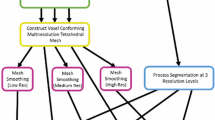Abstract
We propose a learning method which introduces explicit knowledge to the object correspondence problem. Our approach uses an a priori learning set to compute a dense correspondence field between two objects, where the characteristics of the field bear close resemblance to those in the learning set. We introduce a new local shape measure we call the “observed transport measure”, whose properties make it particularly amenable to the matching problem. From the values of our measure obtained at every point of the objects to be matched, we compute a distance matrix which embeds the correspondence problem in a highly expressive and redundant construct and facilitates its manipulation. We present two learning strategies that rely on the distance matrix and discuss their applications to the matching of a variety of 1-D, 2-D and 3-D objects, including the corpus callosum and ventricular surfaces.
Access this chapter
Tax calculation will be finalised at checkout
Purchases are for personal use only
Preview
Unable to display preview. Download preview PDF.
Similar content being viewed by others
References
Pitiot, A., Toga, A., Thompson, P.: Elastic segmentation of brain MRI via shape model guided evolutionary programming. IEEE Trans. on Medical Imaging 21, 910–923 (2002)
Cootes, T.F., Hill, A., Taylor, C.J., Haslam, J.: Use of Active Shape Models for Locating Structures in Medical Images. Image and Vision Computing 12, 355–366 (1994)
Kanai, T., Suzuki, H., Kimura, F.: Metamorphosis of Arbitrary Triangular Meshes. IEEE Computer Graphics and Applications 20, 62–75 (2000)
Trouvé, A., Younes, L.: Diffeomorphic Matching Problems in One Dimension: Designing and Minimizing Matching Functionals. In: Vernon, D. (ed.) ECCV 2000. LNCS, vol. 1842, pp. 573–587. Springer, Heidelberg (2000)
Cohen, I., Ayache, N., Sulget, P.: Tracking Points on Deformable Objects using Curvature Information. In: Sandini, G. (ed.) ECCV 1992. LNCS, vol. 588, pp. 458–466. Springer, Heidelberg (1992)
Fleuté, M., Lavallée, S., Julliard, R.: Incorporating a Statistically Based Shape Model into a System for Computer-Assisted Anterior Cruciate Ligament Surgery. Medical Image Analysis 3, 209–222 (1999)
Wang, Y., Peterson, B., Staib, L.: Shape-Based 3D Surface Correspondence using Geodesics and Local Geometry. In: Proc. of CVPR, pp. 644–651 (2000)
Kelemen, A., Szekely, G., Gerig, G.: Three-Dimensional Model-based Segmentation of Brain MRI. IEEE Trans. on Medical Imaging 18, 838–849 (1999)
Sebastian, T., Crisco, J., Klein, P., Kimia, B.: Constructing 2D Curve Atlases. In: Proc. of CVPR, pp. 70–77 (2000)
Thompson, P., Toga, A.: Detection, Visualisation and Animation of Abnormal Anatomic Structure with a Deformable Probabilistic Brain Atlas Based on Random Vector Field Transformations. Medical Image Analysis 1, 271–294 (1997)
Davatzikos, C., Prince, J., Bryan, N.: Image Registration Based on Boundary Mapping. IEEE Trans. on Medical Imaging 15, 212–215 (1996)
Davies, R., Twining, C., Cootes, T., Waterton, J., Taylor, C.: A Minimum Description Length Approach to Statistical Shape Modelling. IEEE Trans. on Medical Imaging 21 (2002)
Haker, S., Angenent, S., Tannenbaum, A.: Minimizing Flows for the Monge-Kantorovich Problem. SIAM Journal of Mathematical Analysis (2003) (to appear)
Belongie, S., Jitendra, M., Puzicha, J.: Shape Matching and Object Recognition Using Shape Contexts. IEEE Trans. on PAMI 24, 509–522 (2002)
Huot, E., Yahia, H., Cohen, I., Herlin, I.: Surface Matching with Large Deformations and Arbitrary Topology: A Geodesic Distance Evolution Scheme on a 3-Manifold. In: Vernon, D. (ed.) ECCV 2000. LNCS, vol. 1842, pp. 769–783. Springer, Heidelberg (2000)
Cachier, P., Bardinet, E., Dormont, D., Pennec, X., Ayache, N.: Iconic Feature Based Nonrigid Registration: The PASHA Algorithm. CVIU — Special Issue on Nonrigid Registration (2003) (in press)
Author information
Authors and Affiliations
Editor information
Editors and Affiliations
Rights and permissions
Copyright information
© 2003 Springer-Verlag Berlin Heidelberg
About this paper
Cite this paper
Pitiot, A., Delingette, H., Toga, A.W., Thompson, P.M. (2003). Learning Object Correspondences with the Observed Transport Shape Measure. In: Taylor, C., Noble, J.A. (eds) Information Processing in Medical Imaging. IPMI 2003. Lecture Notes in Computer Science, vol 2732. Springer, Berlin, Heidelberg. https://doi.org/10.1007/978-3-540-45087-0_3
Download citation
DOI: https://doi.org/10.1007/978-3-540-45087-0_3
Publisher Name: Springer, Berlin, Heidelberg
Print ISBN: 978-3-540-40560-3
Online ISBN: 978-3-540-45087-0
eBook Packages: Springer Book Archive




